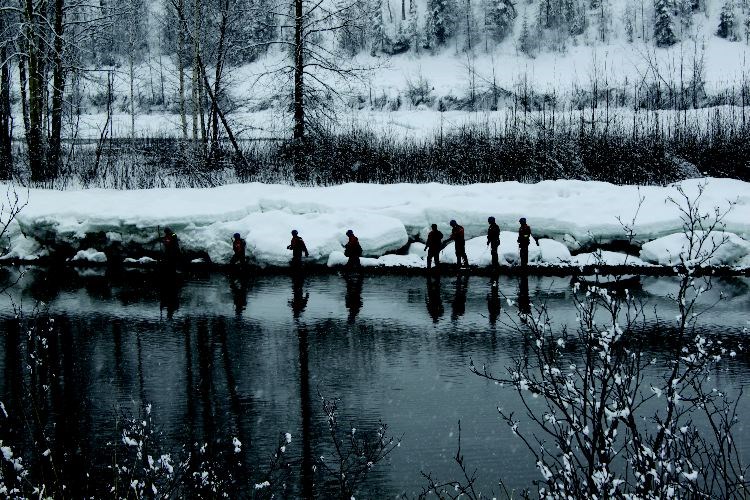It's not your every day sight.
Anyone crossing the Cameron Street bridge on March 4 may have had their interest piqued by the stark contrast of red-clad bodies amid the white ice floes and murky river water.
But the group of 13 people navigating the Nechako River on a decidedly wintery day were putting themselves in a tight situation to prepare for the potential of someone else finding themselves in a similar situation.
Over the first weekend of the month, volunteer firefighters from the Ness Lake, Beaverly, Shell Glen, Salmon Valley and Buckhorn departments donned drysuits for static-ice rescue certification courses.
Taught by Prince George husband and wife team Dean Price and Lauren Phillips, the groups learned how to understand ice environments and hazards in a slow-moving lake or river.
"This type of training is pretty handy, especially in the spring," said Phillips, a search and rescue volunteer who co-leads a variety of outdoor training courses.
The group of volunteer first responders were put through a weekend of theoretical and practical exercises that taught them not only how to rescue others, but also how to rescue themselves.
"If someone's not prepared to self rescue, they shouldn't be putting themselves out there," said Phillips. "It's a pretty major tenant of the whole thing. If you don't understand the environment or you're not prepared to self rescue if things go wrong, you shouldn't be out there."
At Ness Lake on March 3 a group of 20 was put through its paces after drilling a hole in the ice.
Back in town on the following day, the smaller group taking the Level 2 course - which had a greater focus on third-party rescue - grappled with the various straps, ropes and clips necessary to secure the harnesses, personal flotation devices, helmets, boots, gloves and even whistles needed.
With wooden staffs in hand to feel out and bang the ice before stepping on it, and tethered together in groups of four with yellow rope, the volunteers waded out into the Nechako using the dynamic belay system.
"It's borrowed from glacier travel," Phillips explained. "If one of them falls, the others all sit down and become the anchor."
Phillips stressed the importance of self-profiling, asking the volunteers to evaluate if they had enough to eat, too much to eat or if they have enough water. In addition to assessing an ice environment and the hazards, the group was also taught to assess hazards based on their own skill level.
While different first responders have a range of backgrounds, they're often linked by a similar desire to help if someone needs them.
"It's good to have some planning," Phillips said, noting too many would-be rescuers end up injured or killed trying to help someone. "It's far more common than people think."
Although exhausted at the end of the weekend, Phillips said she was really impressed with how much the participants' eyes were opened and how their confidence grew, "especially when we've got these guys wondering when the next course is."

.png;w=120;h=80;mode=crop)

